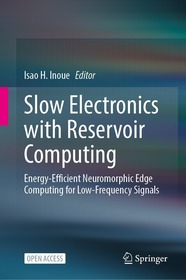
Slow Electronics with Reservoir Computing
Energy-Efficient Neuromorphic Edge Computing for Low-Frequency Signals
- Publisher's listprice EUR 53.49
-
22 184 Ft (21 128 Ft + 5% VAT)
The price is estimated because at the time of ordering we do not know what conversion rates will apply to HUF / product currency when the book arrives. In case HUF is weaker, the price increases slightly, in case HUF is stronger, the price goes lower slightly.
- Discount 12% (cc. 2 662 Ft off)
- Discounted price 19 522 Ft (18 593 Ft + 5% VAT)
Subcribe now and take benefit of a favourable price.
Subscribe
22 184 Ft

Availability
Not yet published.
Why don't you give exact delivery time?
Delivery time is estimated on our previous experiences. We give estimations only, because we order from outside Hungary, and the delivery time mainly depends on how quickly the publisher supplies the book. Faster or slower deliveries both happen, but we do our best to supply as quickly as possible.
Product details:
- Publisher Springer Nature Singapore
- Date of Publication 6 December 2025
- Number of Volumes 1 pieces, Book
- ISBN 9789819683826
- Binding Hardback
- No. of pages160 pages
- Size 235x155 mm
- Language English
- Illustrations VII, 160 p. 69 illus., 54 illus. in color. Illustrations, black & white 700
Categories
Long description:
This open access book discusses “slow electronics”, the study of devices processing signals with low frequencies. Computers have the remarkable ability to process data at high speeds, but they encounter difficulties when handling signals with low frequencies of less than ~100Hz. They unexpectedly require a substantial amount of energy. This poses a challenge for such as biomedical wearables and environmental monitors that need real-time processing of slow signals, especially in energy-limited 'edge’ environments with small batteries.
One possible solution to this issue is event-driven processing, which entails the use of non-volatile memory to read/write data and parameters every time a slow (sporadic) signal is detected. However, this approach is highly energy-consuming and unsuitable for the edge environments. To address this challenge, the authors propose “slow electronics” by developing electronic devices and systems that can process low-frequency signals more efficiently. The biological brain is an excellent example of the slow electronics, as it processes low-frequency signals in real time with exceptional energy efficiency. The authors have employed reservoir computing with a spiking neural network (SNN) to simulate the learning and inference of the brain.
The integration of slow electronics with SNN reservoir computing allows for real-time data processing in edge environments without an internet connection. This will reveal the determinism or periodicity behind unconscious behaviours and habits that have been difficult to explore due to privacy barriers thus far. Moreover, it may provide a more profound understanding of a craftsman's skills, which they may not even be aware of.
This book emphasises the most recent concepts and technological developments in slow electronics. Discussion on the captivating subject of slow electronics are given by delving into the complexities of reservoir calculation, analogue CMOS circuits, artificial neuromorphic devices, and numerical simulation with extended time constants, paving the way for more people-friendly devices in the future.
MoreTable of Contents:
Introduction: what is ‘slow electronics’.- Reservoir Computing Models for Slow Electronics.- Fabricating Elements of Slow Electronics with Functional Materials.- Analog CMOS Implementations of Hardware Neurons for Slow Electronics.- Learning and inference in slow electronics: numerical simulation.- Learning and Inference in slow electronics: FPGA emulation and implementation.- Slow Electronics and Attractor.- Decoding the Unseen, Shaping the Future.
More








